SMOKE AND ASH IN NEW MEXICO
By Mary Hunt Webb
Posted Saturday, June 11, 2011
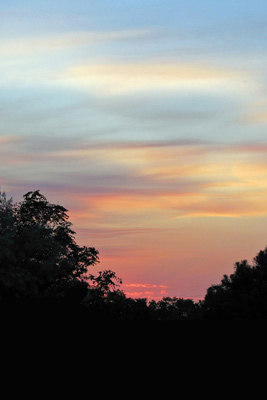
A colorful sunset caused by clouds of smoke on Friday, June 10, 2011. [Photographer: Morris Webb]
I was chatting with a neighbor one evening last week when we smelled smoke. She thought it was another neighbor barbecuing, but the air grew so dark and dense that it was obvious that something else caused it. When I went back inside, I learned that the smoke came from the Wallow Fire in east central Arizona.
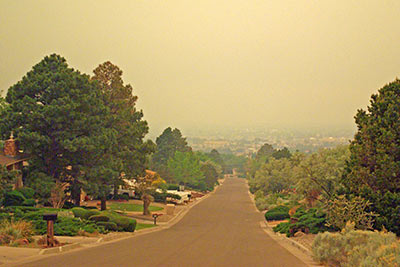
A view to the southwest of the encroaching smoke and ash from the Wallow Fire. The photo was taken the evening of Monday, June 6, 2011. [Photographer: Morris Webb]
Albuquerque does not often make the national headlines. However, we ventured into the news when that huge fire caused thick smoke that enveloped us. Happily, the smoke did not block out the sun during the daytime, but it did make our majestic mountains difficult to see one day. Mainly, the smoke was most visible at sundown as you can see from the reddening sun in the photo below.
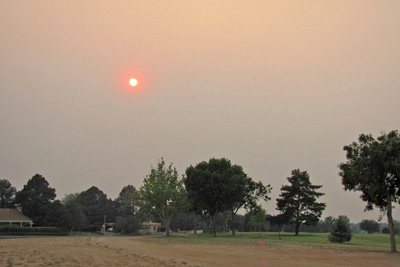
A smoky sunset as viewed from Albuquerque’s Arroyo del Oso Golf Course on Tuesday, June 7, 2011. [Photographer: Morris Webb]
Two days later, I was gardening one evening toward sunset, after the heat of the day had abated, when ash began to fall from the sky. Although I had never experienced ash in the air before, I knew immediately what it was. I quickly gathered up my gardening tools and scooted inside.
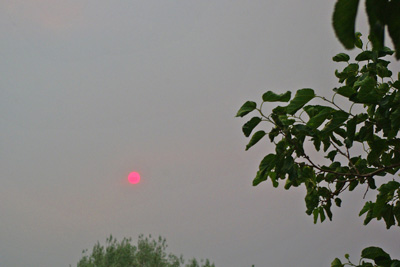
Smoke and ash from the Wallow Fire in Arizona caused the sun to appear violet-red at sunset, Wednesday, June 8, 2011 [Photographer: Morris Webb]
While other parts of the United States have had an abundance of rain that has caused flooding this year, Arizona, New Mexico, and West Texas have experienced drought conditions an average of two years out of every three for the last 15 years. The last noteworthy wet spell in Albuquerque was 2006 when the city received enough moisture to grow small pumpkins in the backyard that summer. That long-term pattern of drought makes the timber in forests prone to fire and infestation by wood-eating insects.
That is the nature of weather. One part of the country suffers from lack of rain while another suffers from too much precipitation. When many eastern and northern states are wetter than average, the Southwest experiences a drought. Conversely, when the eastern states are dry, the Southwest is often wetter than usual. Not surprisingly, weather events that happen near the headquarters of television networks are the ones that receive the most attention. Thus, the flooding that has happened in the eastern part of the United States has received more attention than the prolonged drought in the Southwest.
If justice ruled life and journalism, media networks would place their headquarters near the geographical center of the United States for a more balanced focus of events. That would put them 20 miles north of Belle Fourche, in the northwest part of South Dakota. Obviously, there are no plans for media networks to move their headquarters near that town of about 5,000 people!
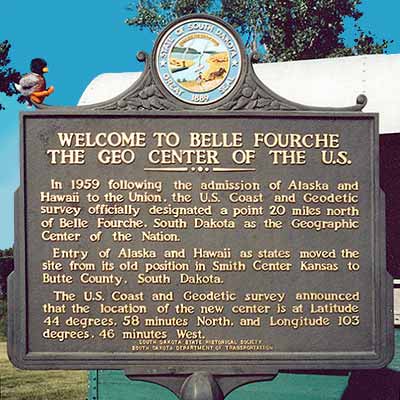
Geographical center marker in Belle Fourche, South Dakota. While you will find the geographical center of the United States in South Dakota, you won’t find any media networks headquartered there. [Photo courtesy of Wikipedia.org.]
When weather cycles reverse so that the eastern states experience a drought and fires, the media will focus on that weather pattern as if it were the approach of the end times. When that happens, please remember that not even Jesus Christ was able to tell His disciples when that would be. In Matthew 24:36, Jesus said, “But of that day and hour no one knows, not even the angels of heaven, but My Father only.” (New King James Version)
While I don’t wish a drought on anyone, the reversal of circumstances is part of a recurring pattern. Count on it. When that occurs, those of us in the Southwest will receive sufficient rain to enable us to plant pumpkins, melons, and other water-loving produce that are normally so difficult to grow in the desert. I look forward to that.
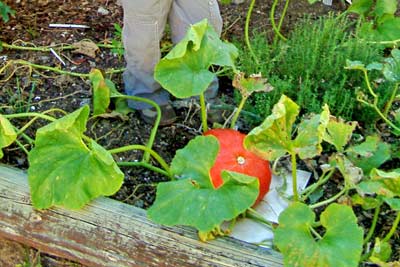
Several small pumpkins survived the heat and the insects in 2006 when much of New Mexico received abundant precipitation during the summer rainy season. [Photographer: Morris Webb]

